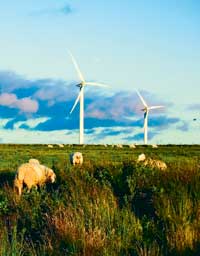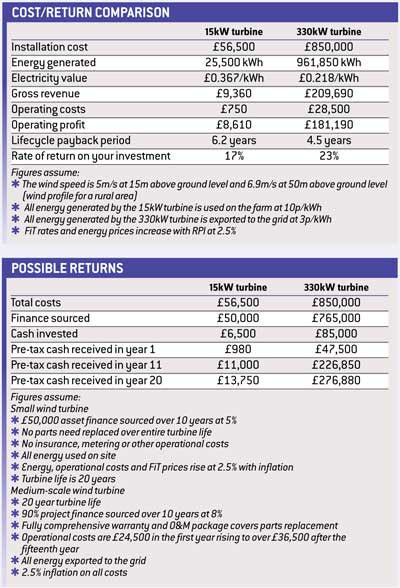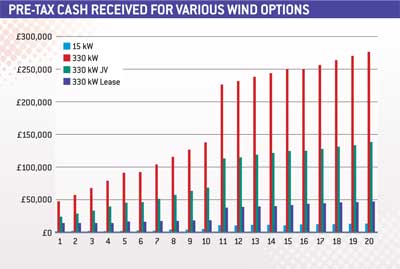Avoid the wind energy stumbling blocks

Small to medium-scale wind turbines can provide attractive returns, providing you do your homework first. Andrew Lyle from wind energy developer Locogen outlines how to avoid common pitfalls
With the introduction of the UK’s Feed-in Tariff scheme in April 2010, wind energy offers an excellent diversification opportunity for landowners and farmers.
A popular option available to many farmers is to install one or more small 10-15kW wind turbines. The capital cost is considerably less than larger units, planning is easier to come by, and the risks are fewer.
However, where you have a suitable site and the commitment to take the project forward, a wind turbine up to 500kW in rated capacity offers substantially more attractive returns, as the tables below illustrate.
Where the initial cash investment is too high or the risks are considered too great, there is an opportunity to either partner with an experienced developer, or rent out your site for a guaranteed annual income.

Figure 1 illustrates the 20-year pre-tax cash received forecasts for small and medium-scale wind turbines, alongside the cash received in a 50/50 joint venture or from a typical rent for a medium-scale wind turbine option. This shows that owning a medium-scale wind turbine is the most attractive option; however leasing the land to a developer will still net a higher income than a small wind turbine without the upfront capital costs or risks.

WHAT ARE THE RISKS?
Planning and environmental limitations
The cost of preparing a full planning application with supporting environmental documentation is usually between £20,000 and £30,000, and can be substantially more at sensitive sites. Some organisations will submit a planning application for less than this, but watch out: These organisations rarely provide robust supporting environmental documentation and as a result many applications are rejected.
• How to avoid
Carry out a thorough screening study before applying for planning. Include all statutory and non-statutory consultees to ensure there are no objections to your project. This will typically take three months, but could save thousands at the planning stage if you find a serious objection.
Grid connection availability
A medium-scale wind turbine can have a significant impact on the local grid network, and grid connection costs can be extremely high. In addition, when an offer to connect is received, you have to pay a deposit to secure the connection, with no guarantee you will get your money back if the project fails.
• How to avoid…..
Assess your grid capacity and the likely upgrade works required to connect at your site as early as possible. This can be carried out through early consultation with the distribution network operator and via a grid connection feasibility study. Also, time your application for connection so that the offer is returned at the same time as the planning decision so you don’t have to risk the connection deposit.
Wind resource
The power a wind turbine generates is extremely sensitive to the wind resource at a site. A small change in the wind speed can have a huge impact on the energy generated. Get this wrong and your return won’t seem as rosy.
• How to avoid
Carry out a wind resource assessment before a wind turbine is purchased. The type of assessment you carry out is dependent on the size of wind turbine and the type of finance you source for the project.
In the case of a medium-scale turbine with project finance, a wind monitoring station installed for up to 12 months is likely to be necessary. The lender will also carry out due diligence on the wind resource assessment before a loan is agreed. This process can be by-passed if a neighbour has already carried out a suitable study and is willing to provide/ sell the data to you.
In the case of a small wind project or where asset finance is secured, you are personally liable if the wind resource is poor and your own assets will cover repayment of the loan.
Supplier choice
How do you choose the right turbine supplier? Project finance may not be available for certain technologies and performance – efficiency, durability and therefore the return varies from one manufacturer to the next.
• How to avoid
Get the right information from the supplier:
• Check if there are references you can contact to find out about service, performance, etc
• Make sure the warranty is fully comprehensive (parts and labour) and covers the period of the debt taken out on the turbine
• Find out if the supplier offers an availability guarantee. Does it compensate you for loss of income when the wind turbine is not generating?
If you are looking for a small wind turbine, also check out the Energy Savings Trust‘s field trial of domestic and small scale wind turbines called “Location, Location, Location”, which provides objective information on the performance of turbines from a range of small manufacturers.
Where the turbine manufacturer does not offer a fully comprehensive warranty and operation and maintenance package, it is worth investing in an insurance package to cover breakdown costs.
Timing
The Feed-in Tariff (FiT) scheme in its current structure is only guaranteed through to 2013, after which there will be a review of tariff rates. There is a risk that turbines installed after 2013 will have a lower FiT rate, and therefore less attractive returns.
• How to avoid
Prepare a robust planning application and supporting environmental documentation to minimise planning risk.
Apply for your grid connection quickly so that the offer is available at the same time as the planning decision is confirmed.
Select a turbine manufacturer that is approved from the key lenders and has the shortest lead times.
Keep abreast of changes to the FiT scheme, which should start to be announced in 2011 and 2012.
